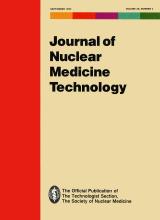Abstract
The Nuclear Regulatory Commission has defined the limit for worker dose from radioaerosol studies. Clinics performing aerosol studies must calculate their worker dose and keep it on file for inspection. Comments made by technologists, as well as the findings reported in the literature, suggest that technologists are concerned about their occupational exposure from aerosol studies and how it can be most effectively minimized. Our investigation was conducted to compare the limit for worker dose from aerosols with measured air concentrations in the work area. We also wanted to determine the extent and causes of surface contamination from aerosol studies. Samples were collected during 35 aerosol studies at 4 different hospitals. The resulting data consisted of measured airborne aerosol concentrations and area wipe test counts for removable contamination. The patient’s ability to cooperate was evaluated and recorded, as well as the aerosol equipment used in each case by each hospital. On average, air concentrations and floor and nasal contamination increased as the patient’s ability to cooperate decreased. Contamination did not appear to be higher with any particular aerosol equipment. The patient’s ability or inability to cooperate did not always correlate with the amount of contamination found. Patient practice and coaching appears to result in less contamination. We recommend that each clinic performing radioaerosol studies conduct an investigation similar to ours to assess the extent of contamination in the clinic and to determine if any corrective actions are indicated.







